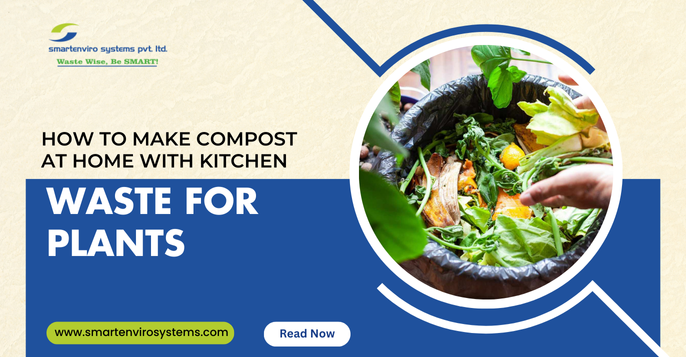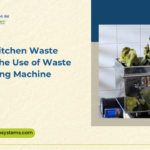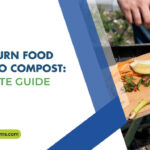Sustainability is more imperative today than it ever has been. Composting kitchen wastes is an accessible, small but effective way to be a part of it. Composting is the natural process for controlling the turn of organic materials into a nutrient-rich soil conditioner that benefits plants, reduces waste, and supports a healthier environment. With the use of tools such as a composter machine or even basic DIY methods, you are able to easily convert kitchen scraps into something valuable for your garden.
This guide will walk you through step-by-step the process of how to compost at home from kitchen waste and how composting helps plants. You’ll also know the advantages of using a composting machine, organic waste composter machine, or an organic waste converter to make the process much faster and more efficient.
What is Compost and How is it Made?
This is biologically breaking down organic materials into simpler components. This happens naturally since organic waste breaks down by way of microbes like bacteria and fungi. Gradually, the microbes feed on the waste and break it down into humus: dark, crumbly material that resembles soil, yet it is full of nutrients for plants.
Four elements balance in the creation of compost
1. Organic Matter: This entails kitchen waste such as fruit and vegetable leftovers, eggshells, and coffee grounds, while the yard waste includes grass clippings and leaves.
2.Moisture: This is water necessary to keep the pile active but should not wet. Ideal is when it looks like a sponge that is damp.
3.Air: Oxygen is necessary to the aerobes responsible for decomposing the organic matter. If you mix your compost pile regularly, this will enable it to supply aeration and increase decomposition.
4. Temperature: As organic waste decomposes, it produces heat. A warm compost pile ideally in the range of 130-160°F accelerates the composting process.
Using a composter machine or organic waste converter can help automate and optimize these elements, making it easier to produce compost without too much manual effort.
Why Should I Compost at Home?
Home composting is the simplest way of reducing carbon footprint and encouraging sustainable living. Your kitchen waste is turned into compost, and therefore does not have a chance of lying in landfills where it rots, emitting toxic methane gas. Instead, you are recycling the waste into a product that improves the health of your soils and that serves as an input to plant growth.
How to Compost at Home Using Kitchen Waste
Composting kitchen waste at home does not even require a big garden or expensive equipment; an organic waste composter machine certainly simplifies the process. Here is a very brief guide to get you started with minimal tools:
Step 1: Set Up Your Composting Area
The first thing you will need is a designated area for your compost. Many people will do this by building a backyard compost pile, but smaller indoor compost bins work just as well for the apartment or home without outdoor space.
Outdoor composting: For dry and shady site locations, preferably near a water source. Compost pile can either be placed on the ground or contained in a bin.
Indoor composting: You can use a countertop compost bin with a tight-lid to reduce odor. Alternatively, you invest in a composting machine for use indoors.
Step 2: Collect Kitchen Waste
Not all “kitchen waste” will go into a compost pile. It pays to know what goes in and what does not belong. The ideal materials to use for composting are your “green” and “brown” materials.
Greens: Green materials are nitrogen-rich, including fruit and vegetable scraps, coffee grounds, tea leaves, and grass clippings.
Browns: Brown materials are carbon-rich, such as dry leaves, newspapers, cardboard, sawdust, and shredded paper.
A good compost pile contains both greens and browns, and decomposes well. A general estimate is to have three parts of browns to one part of greens.
What to compost
Fruits and vegetables peels
Coffee grounds and filters
Tea bags
Crushed eggshells
Nut shells
Paper and cardboard (torn into shreds)
Do not compost the following:
Meat, fish, and bones
Dairy products
Grease, oils, and fats
Diseased plants
Pet waste
Step 3: Creating the Compost Pile
Start by creating your compost pile in a layered fashion of greens and browns. Have your bottom layer of browns help with drainage and air circulation, alternating layers of adding greens in layers. Collect the scraps of your kitchen and continue adding them on top as you scrape them together.
If you are using organic waste converter or composting machine, the process is even easier because it will mix and aerate materials for you. Equipment also takes care of temperature and moisture levels, which enables faster decomposition.
Step 4: Turning and maintaining the pile
Aeration is also one of the critical elements of composting. The compost pile should be turned every few weeks with a pitchfork or shovel to allow air to get in so it decomposes faster and does not have that horrid smell. This depends on the kind of composter you have because some machines have an automatic turning mechanism.
Monitor its water content, too. Ideally, the pile should be moist, like a squeezed sponge. If it dries out, just sprinkle a little water on it. If it’s too soggy, add a lot of dry materials, such as shredded paper or cardboard, to absorb the excess water.
Step 5: Collect Your Compost
Composting is quite a slow process and may take as long as three months or up to a year depending on the factors. It is ready to be collected once the bottom of the pile has decomposed into a dark crumbly piece of matter that can be described as soil.
If a composting machine is used, then this process will be much faster, and ready-to-use compost is available within weeks.
How to Use Compost for Plants
The ready-made compost can then be utilized in different ways to feed your plants. Your compost is full of essential nutrients that include nitrogen, phosphorus, and potassium – factors important to the plant’s development. Here’s how you make it count:
Soil Amendment: Add compost to garden beds to improve soil structure, retain water, and increase microbial activity.
Mulching: A layer of compost around the base of plants should be allowed. It helps to retain the moisture and prevent weeds.
Compost-Potting Mix: For indoor plants, use compost-potting mix. It offers extra nutrient feed for your plants.
Benefits of Using a Composting Machine
A potential organic waste composter machine is a great fit for those interested in quicker and more efficient composting methods. The devices can automate the composting process for a smoother management of domestic waste without constant attention. They also are more space-saving and produce compost much faster than the traditional methods.
Key benefits:
They decompose the materials faster
Less manual work-the pile does not require to be turned
No bad odor in indoor use
Portable, ideal for small rooms
Conclusion
Home composting is relatively easy to establish, reducing waste output, enhancing the health of the garden, and promoting a greener lifestyle. A composting machine or an organic waste converter will bring rapid results, and kitchen waste will never be wasted again.
Then, why wait? Start composting today and watch as your plants bloom into healthy blooms with the introduction of nutrient-rich compost!



